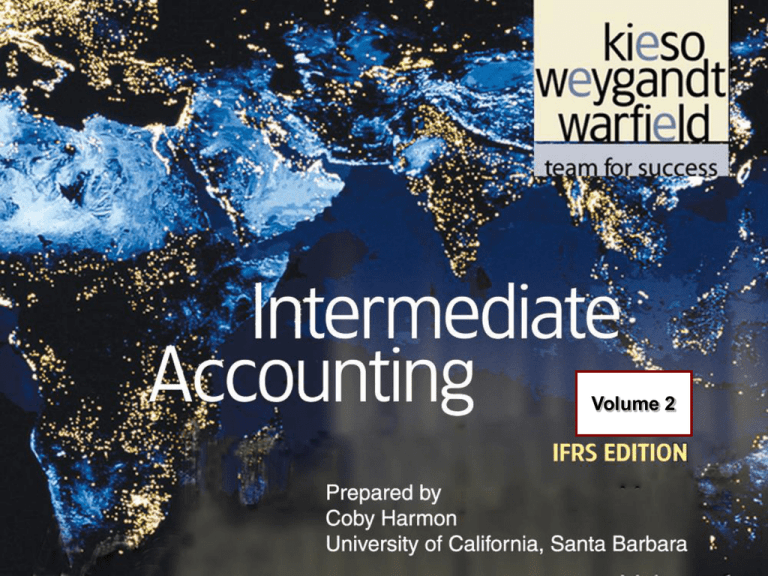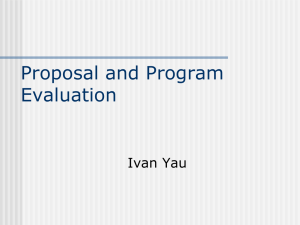
Volume 2
18-1
CHAPTER
18
REVENUE
Intermediate Accounting
IFRS Edition
Kieso, Weygandt, and Warfield
18-2
Learning Objectives
18-3
1.
Apply the revenue recognition principle.
2.
Describe accounting issues for revenue recognition at point of
sale.
3.
Apply the percentage-of-completion method for long-term
contracts.
4.
Apply the cost-recovery method for long-term contracts.
5.
Identify the proper accounting for losses on long-term contracts.
6.
Describe the accounting issues for service contracts.
7.
Identify the proper accounting for multiple-deliverable
arrangements.
Revenue
Current
Environment
Guidelines for
revenue
recognition
Departures from
sale basis
Revenue
Recognition
(At Point of Sale)
Measurement
Recognition
Summary
Revenue
Recognition (LongTerm Contracts)
Percentage-ofcompletion method
Cost-recovery
method
Long-term contract
losses
Disclosures
18-4
Revenue
Recognition
(Other)
Service contracts
Multipledeliverable
arrangements
Other
Summary of
methods
The Current Environment
Revenue recognition is a top fraud risk and regardless
of the accounting rules followed (IFRS or U.S. GAAP),
the risk or errors and inaccuracies in revenue reporting is
significant.
Restatements for improper revenue recognition are
relatively common and can lead to significant share price
adjustments.
18-5
The Current Environment
Guidelines for Revenue Recognition
Revenue recognition principle: Revenue is recognized
(1) when it is probable that the economic benefits will
flow to the company and
(2) when the benefits can be measured reliably.
18-6
LO 1 Apply the revenue recognition principle.
The Current Environment
Revenue Recognition Classified by Nature of Transaction
Illustration 18-1
Type of
Transaction
Sale of product
from inventory
Rendering a
service
Permitting use
of an asset
Sale of asset
other than
inventory
Description
of Revenue
Revenue from
sales
Revenue from
fees or services
Revenue from
interest, rents,
and royalties
Gain or loss on
disposition
Timing of
Revenue
Recognition
Date of sale
(date of
delivery)
Services
performed and
billable
As time passes
or assets are
used
Date of sale or
trade-in
18-7
LO 1 Apply the revenue recognition principle.
The Current Environment
Departures from the Sale Basis
Earlier recognition is appropriate if there is a high degree of
certainty about the amount of revenue earned.
Delayed recognition is appropriate if the
degree of uncertainty concerning the amount of revenue
or costs is sufficiently high or
sale does not represent substantial completion of the
earnings process.
18-8
LO 1 Apply the revenue recognition principle.
Revenue Recognition at Point of Sale
Measurement of Sale Revenue
Revenue should be measured at the fair value of
consideration received or receivable.
18-9
Trade discounts or volume rebates should reduce
consideration received or receivable and the related
revenue.
If payment is delayed, seller should impute an interest
rate for the difference between the cash or cash
equivalent price and the deferred amount.
LO 2 Describe accounting issues for revenue recognition at point of sale.
Revenue Recognition at Point of Sale
Illustration 18-2
18-10
LO 2 Describe accounting issues for revenue recognition at point of sale.
Revenue Recognition at Point of Sale
Illustration 18-2
Sansung makes the following entry on March 31, 2011.
Accounts receivable
Sales
18-11
679,000
679,000
LO 2 Describe accounting issues for revenue recognition at point of sale.
Revenue Recognition at Point of Sale
Illustration 18-2
Assuming Sansung’s customers meet the discount threshold,
Sansung makes the following entry.
Cash
679,000
Accounts receivable
18-12
679,000
LO 2 Describe accounting issues for revenue recognition at point of sale.
Revenue Recognition at Point of Sale
Illustration 18-2
If Sansung’s customers fail to meet the discount threshold,
Sansung makes the following entry upon payment.
Cash
700,000
Accounts receivable
Sales discounts forfeited
18-13
679,000
21,000
LO 2 Describe accounting issues for revenue recognition at point of sale.
Revenue Recognition at Point of Sale
Measurement of Sale Revenue
When a sales transaction involves a financing arrangement, the
fair value is determined by discounting the payment using an
imputed interest rate.
Imputed interest rate is the more clearly determinable of either
1. the prevailing rate for a similar instrument of an issuer with a
similar credit rating, or
2. a rate of interest that discounts the nominal amount of the
instrument to the current sales price of the goods or services.
18-14
LO 2 Describe accounting issues for revenue recognition at point of sale.
Revenue Recognition at Point of Sale
Illustration 18-3
18-15
LO 2 Describe accounting issues for revenue recognition at point of sale.
Revenue Recognition at Point of Sale
Illustration 18-3
The journal entry to record SEK’s sale to Grant Company on
July 1, 2011, is as follows (ignoring cost of goods sold entry).
Notes receivable
Sales
18-16
900,000
900,000
LO 2 Describe accounting issues for revenue recognition at point of sale.
Revenue Recognition at Point of Sale
Illustration 18-3
SEK makes the following entry to record interest revenue.
Notes receivable
Interest revenue (12% x ½ x €900,000)
18-17
54,000
54,000
LO 2 Describe accounting issues for revenue recognition at point of sale.
Revenue Recognition at Point of Sale
Recognition of Sale Revenue
Revenue from the sale of goods is recognized when all the following
conditions are met:
1. Company has transferred to the buyer the significant risks and
rewards of ownership of the goods;
2. Company retains neither continuing managerial involvement to the
degree usually associated with ownership nor effective control over
the goods sold;
3. The amount of revenue can be measured reliably;
4. It is probable that the economic benefits will flow to the company; and
5. The costs incurred or to be incurred can be estimated reliably.
18-18
LO 2
Revenue Recognition at Point of Sale
Bill and Hold Sales
Buyer is not yet ready to take delivery but does take title and
accept billing.
Illustration 18-4
18-19
LO 2 Describe accounting issues for revenue recognition at point of sale.
Revenue Recognition at Point of Sale
Solution: Butler should record the revenue at the time title
passes, provided
1. it is probable that delivery will be made;
2. the item is on hand, identified, and ready for delivery at
the time the sale is recognized;
3. Baristo acknowledges the deferred delivery arrangement;
and
4. the usual payment terms apply.
It appears that these conditions were probably met and
therefore revenue recognition should be permitted at the time
the agreement is signed.
18-20
LO 2
Revenue Recognition at Point of Sale
Illustration 18-4
Butler makes the following entry to record the bill and hold sale.
Accounts receivable
Sales
18-21
450,000
450,000
LO 2 Describe accounting issues for revenue recognition at point of sale.
Revenue Recognition at Point of Sale
Sales Subject to Installation or Inspection
Illustration 18-5
18-22
LO 2 Describe accounting issues for revenue recognition at point of sale.
Revenue Recognition at Point of Sale
Layaway Sales
Illustration 18-6
18-23
LO 2 Describe accounting issues for revenue recognition at point of sale.
Revenue Recognition at Point of Sale
Sales with Right of Return
Two possible revenue recognition methods are available when
the right of return exposes the seller to continued risks of
ownership:
1. not recording a sale until all return privileges have expired
or
2. recording the sale, but reducing sales by an estimate of
future returns.
18-24
LO 2 Describe accounting issues for revenue recognition at point of sale.
Revenue Recognition at Point of Sale
Illustration 18-7
18-25
LO 2 Describe accounting issues for revenue recognition at point of sale.
Revenue Recognition at Point of Sale
Pesido sold $300,000 of laser equipment on August 1, 2011, and
retains only an insignificant risk of ownership. On October 15,
2011, $10,000 in equipment was returned.
August 1, 2011
Accounts receivable
300,000
Sales
300,000
October 15, 2011
Sales returns and allowances
Accounts receivable
18-26
10,000
10,000
LO 2
Revenue Recognition at Point of Sale
At December 31, 2011, based on prior experience, Pesido
estimates that returns on the remaining balance will be 4 percent.
Pesido makes the following entry to record the expected returns.
December 31, 2011
Sales returns and allowances
Allowance for sales returns and allowances
11,600
11,600
[($300,000 - $10,000) x 4% = 11,600]
18-27
LO 2 Describe accounting issues for revenue recognition at point of sale.
Revenue Recognition at Point of Sale
Illustration 18-8
18-28
LO 2 Describe accounting issues for revenue recognition at point of sale.
Revenue Recognition at Point of Sale
Illustration 18-8
Morgan records the sale and related cost of goods sold as follows.
Cash
135,000
Sales
Cost of Goods Sold
Inventory
18-29
135,000
115,000
115,000
LO 2 Describe accounting issues for revenue recognition at point of sale.
Revenue Recognition at Point of Sale
Principal-Agent Relationships
18-30
Amounts collected on behalf of the principal are not
revenue of the agent.
Revenue for the agent is the amount of the commission it
receives.
LO 2 Describe accounting issues for revenue recognition at point of sale.
Revenue Recognition at Point of Sale
Consignments
18-31
Manufacturers (or wholesalers) deliver goods but retain
title to the goods until they are sold.
Consignor (manufacturer or wholesaler) ships
merchandise to the consignee (dealer), who is to act as
an agent for the consignor in selling the merchandise.
Consignor makes a profit on the sale.
Consignee makes a commission on the sale.
LO 2 Describe accounting issues for revenue recognition at point of sale.
Revenue Recognition at Point of Sale
Trade Loading and Channel Stuffing
Trade loading - a crazy, uneconomic, insidious practice through
which manufacturers—trying to show sales, profits, and market
share they don’t actually have—induce their wholesale
customers, known as the trade, to buy more product than they
can promptly resell.
Channel stuffing. When a software maker needed to make its
financial results look good, it offered deep discounts to its
distributors to overbuy, and then recorded revenue when the
software left the loading dock.
18-32
LO 2 Describe accounting issues for revenue recognition at point of sale.
Long-Term Contracts (Construction)
Two methods of accounting for long-term construction
contracts:
18-33
Percentage-of-completion method.
Cost-recovery (zero-profit) method.
Long-Term Contracts (Construction)
Rationale for using percentage-of-completion accounting
is that under most of these contracts, the
18-34
Buyer and seller have enforceable rights.
Buyer has the legal right to require specific performance on
the contract.
Seller has the right to require progress payments that
provide evidence of the buyer’s ownership interest.
As a result, a continuous sale occurs as the work progresses
and companies should recognize revenue according to that
progression.
Long-Term Contracts (Construction)
Companies must use the percentage-of-completion method
when all of the following conditions exist.
1. Total contract revenue can be measured reliably;
2. It is probable that the economic benefits associated with the
contract will flow to the company;
3. Both the contract costs to complete the contract and the stage
of contract completion at the end of the reporting period can
be measured reliably; and
4. The contract costs attributable to the contract can be clearly
identified and measured reliably so the actual contract costs
incurred can be compared with prior estimates.
18-35
Long-Term Contracts (Construction)
Companies should use the cost-recovery method when one
of the following conditions applies:
1. When a company cannot meet the conditions for using the
percentage-of-completion method, or
2. When there are inherent hazards in the contract beyond the
normal, recurring business risks.
18-36
Long-Term Contracts (Construction)
Percentage-of-Completion Method
Calculation for Revenue to Be Recognized
Illustration 18-11
Illustration 18-12
Illustration 18-13
18-37
LO 3 Apply the percentage-of-completion method for long-term contracts.
Long-Term Contracts (Construction)
Illustration: KC Construction Company has a contract to
construct a €4,500,000 bridge at an estimated cost of
€4,000,000. The contract is to start in July 2010, and the
bridge is to be completed in October 2012. The following data
pertain to the construction period.
18-38
LO 3 Apply the percentage-of-completion method for long-term contracts.
Long-Term Contracts (Construction)
Illustration: Compute percentage complete.
Illustration 18-6
18-39
LO 3 Apply the percentage-of-completion method for long-term contracts.
Long-Term Contracts (Construction)
Illustration: KC would make the following entries to record
(1) the costs of construction, (2) progress billings, and (3)
collections.
Illustration 18-7
18-40
LO 3 Apply the percentage-of-completion method for long-term contracts.
Long-Term Contracts (Construction)
Percentage-of-Completion, Revenue and Gross Profit, by Year
Illustration 18-16
18-41
Long-Term Contracts (Construction)
Illustration: KC’s entries to recognize revenue and gross
profit each year and to record completion and final approval
of the contract.
Illustration 18-17
18-42
LO 3 Apply the percentage-of-completion method for long-term contracts.
Long-Term Contracts (Construction)
Illustration: Content of Construction in Process Account—
Percentage-of-Completion Method
Illustration 18-18
18-43
LO 3 Apply the percentage-of-completion method for long-term contracts.
Long-Term Contracts (Construction)
Financial Statement Presentation—Percentage-ofCompletion
Computation of Unbilled Contract Price at 12/31/10
Illustration 18-19
18-44
LO 3 Apply the percentage-of-completion method for long-term contracts.
Long-Term Contracts (Construction)
Financial Statement—Percentage-of-Completion
Illustration 18-20
18-45
LO 3
Cost-Recovery (Zero-Profit) Method
Illustration: For the bridge project illustrated on the preceding pages,
Hardhat Construction would report the following revenues and costs.
Illustration 18-21
18-46
LO 4 Apply the cost-recovery method for long-term contracts.
Cost-Recovery (Zero-Profit) Method
Illustration: Hardhat’s entries to recognize revenue and gross profit
each year and to record completion and final approval of the contract.
Illustration 18-22
18-47
LO 4 Apply the cost-recovery method for long-term contracts.
Cost-Recovery (Zero-Profit) Method
Illustration: Comparison of gross profit recognized under different
methods.
Illustration 18-23
18-48
LO 4 Apply the cost-recovery method for long-term contracts.
Long-Term Contracts (Construction)
Financial Statement—Cost-Recovery Method
Illustration 18-24
18-49
LO 4 Apply the cost-recovery method for long-term contracts.
Long-Term Contracts (Construction)
Illustration:
Casper Construction Co.
Contract price
Cost incurred current year
Estimated cost to complete
in future years
Billings to customer current year
Cash receipts from customer
Current year
2010
€675,000
150,000
2011
€675,000
287,400
2012
€675,000
170,100
450,000
135,000
170,100
360,000
0
180,000
112,500
262,500
300,000
A) Prepare the journal entries for 2010, 2011, and 2012.
18-50
LO 3 Apply the percentage-of-completion method for long-term contracts.
Long-Term Contracts (Construction)
Illustration:
2010
2011
2012
€ 150,000
€ 437,400
€ 607,500
Estimated cost to complete
450,000
170,100
Est. total contract costs
600,000
607,500
Costs incurred to date
Est. percentage complete
25.0%
72.0%
607,500
100.0%
Contract price
675,000
675,000
675,000
Revenue recognizable
168,750
486,000
675,000
(168,750)
(486,000)
Rev. recognized prior year
Rev. recognized currently
168,750
317,250
189,000
Costs incurred currently
(150,000)
(287,400)
(170,100)
Gross profit recognized
€ 18,750
€ 29,850
€ 18,900
18-51
LO 3 Apply the percentage-of-completion method for long-term contracts.
Long-Term Contracts (Construction)
Illustration:
2010
150,000
150,000
2011
287,400
287,400
2012
170,100
170,100
Accounts receivable
Billings on contract
135,000
360,000
180,000
Cash
Accounts receivable
112,500
Construction in progress
Construction expense
Construction revenue
18,750
150,000
Construction in progress
Cash
Billings on contract
Construction in progress
18-52
135,000
360,000
262,500
112,500
300,000
262,500
29,850
287,400
168,750
180,000
300,000
18,900
170,100
317,250
189,000
675,000
675,000
LO 3 Apply the percentage-of-completion method for long-term contracts.
Long-Term Contracts (Construction)
Illustration:
Income Statement
Revenue on contracts
Cost of construction
Gross profit
Balance Sheet (12/31)
Current assets:
Accounts receivable
Cost & profits > billings
Current liabilities:
Billings > cost & profits
18-53
2010
2011
2012
$ 168,750
150,000
18,750
$ 317,250
287,400
29,850
$ 189,000
170,100
18,900
22,500
33,750
120,000
-
9,000
LO 3 Apply the percentage-of-completion method for long-term contracts.
Long-Term Contracts (Construction)
Cost-Recovery Method
Companies recognize revenue only to the extent of costs
incurred that are expected to be recoverable.
Only after all costs are incurred is gross profit recognized.
18-54
LO 4 Apply the cost-recovery method for long-term contracts.
Cost-Recovery Method
Illustration:
2010
150,000
150,000
2011
287,400
287,400
2012
170,100
170,100
Accounts receivable
Billings on contract
135,000
360,000
180,000
Cash
Accounts receivable
112,500
Construction in progress
Cash
135,000
262,500
112,500
Construction in progress
Construction expense
Construction revenue
150,000
180,000
300,000
262,500
300,000
67,500
170,100
287,400
150,000
Billings on contract
Construction in progress
18-55
360,000
287,400
237,600
675,000
675,000
LO 4 Apply the cost-recovery method for long-term contracts.
Cost-Recovery Method
Illustration:
Income Statement
Revenue on contracts
Cost of construction
Gross profit
Balance Sheet (12/31)
Current assets:
Accounts receivable
Cost & profits > billings
Current liabilities:
Billings > cost & profits
18-56
2010
2011
€0
-
€0
-
22,500
15,000
120,000
2012
€ 675,000
607,500
67,500
-
57,600
LO 4 Apply the cost-recovery method for long-term contracts.
Long-Term Contracts (Construction)
Long-Term Contract Losses
Loss in the Current Period on a Profitable Contract
►
Loss on an Unprofitable Contract
►
18-57
Percentage-of-completion method only, the estimated
cost increase requires a current-period adjustment of
gross profit recognized in prior periods.
Under both percentage-of-completion and completedcontract methods, the company must recognize in the
current period the entire expected contract loss.
LO 5 Identify the proper accounting for losses on long-term contracts.
Long-Term Contract Losses
Illustration: Loss in Current Period
Casper Construction Co.
Contract price
Cost incurred current year
Estimated cost to complete
in future years
Billings to customer current year
Cash receipts from customer
Current year
2010
€675,000
150,000
2011
€675,000
287,400
2012
€675,000
215,436
450,000
135,000
215,436
360,000
0
180,000
112,500
262,500
300,000
b) Prepare the journal entries for 2010, 2011, and 2012 assuming the estimated
cost to complete at the end of 2011 was €215,436 instead of €170,100.
18-58
LO 5 Identify the proper accounting for losses on long-term contracts.
Long-Term Contract Losses
Illustration: Loss in Current Period
2010
2011
2012
€ 150,000
€ 437,400
€ 652,836
Estimated cost to complete
450,000
215,436
Est. total contract costs
600,000
652,836
Costs incurred to date
Est. percentage complete
25.0%
67.0%
652,836
100.0%
Contract price
675,000
675,000
675,000
Revenue recognizable
168,750
452,250
675,000
(168,750)
(452,250)
Rev. recognized prior year
Rev. recognized currently
168,750
283,500
222,750
Costs incurred currently
(150,000)
(287,400)
(215,436)
Gross profit recognized
€ 18,750
(€ 3,900)
€ 7,314
18-59
LO 5 Identify the proper accounting for losses on long-term contracts.
Long-Term Contract Losses
Illustration: Loss in Current Period
2010
Construction in progress
Construction expense
Construction revenue
Construction in progress
Construction expense
Construction revenue
18-60
2011
2012
18,750
150,000
7,314
215,436
168,750
222,750
3,900
287,400
283,500
LO 5 Identify the proper accounting for losses on long-term contracts.
Long-Term Contract Losses
Illustration: Loss on Unprofitable Contract
Casper Construction Co.
Contract price
Cost incurred current year
Estimated cost to complete
in future years
Billings to customer current year
Cash receipts from customer
Current year
2010
€675,000
150,000
2011
€675,000
287,400
2012
€675,000
246,038
450,000
135,000
246,038
360,000
0
180,000
112,500
262,500
300,000
c) Prepare the journal entries for 2010, 2011, and 2012 assuming the estimated
cost to complete at the end of 2011 was € 246,038 instead of € 170,100.
18-61
LO 5 Identify the proper accounting for losses on long-term contracts.
Long-Term Contract Losses
Illustration: Loss on Unprofitable Contract
2010
Costs incurred to date
2011
€ 150,000
€ 437,400
Estimated cost to complete
450,000
246,038
Est. total contract costs
600,000
683,438
Est. percentage complete
25.0%
2012
€ 683,438
683,438
64.0%
100.0%
Contract price
675,000
675,000
675,000
Revenue recognizable
168,750
432,000
675,000
(168,750)
(432,000)
Rev. recognized prior year
Rev. recognized currently
168,750
263,250
243,000
Costs incurred currently
(150,000)
(290,438)
(243,000)
Gross profit recognized
€ 18,750
(€ 27,188)
€0
$675,000 – 683,438 = (8,438) cumulative loss
18-62
Plug
LO 5
Long-Term Contract Losses
Illustration: Loss on Unprofitable Contract
2010
Construction in progress
Construction expense
Construction revenue
Construction in progress
Construction expense
Construction revenue
18-63
2011
2012
18,750
150,000
243,000
168,750
243,000
27,188
290,438
263,250
LO 5 Identify the proper accounting for losses on long-term contracts.
Long-Term Contract Losses
Illustration: Loss on Unprofitable Contract
For the Cost-Recovery method, companies would recognize the
following loss:
2010
Loss on construction contract
2011
8,438
Construction in progress
Construction expense
Construction revenue
18-64
8,438
287,400
287,400
LO 5 Identify the proper accounting for losses on long-term contracts.
Long-Term Contract Losses
Disclosures in Financial Statements
Construction contractors should disclosure:
Revenue recognized during the period and the methods used to
determine the contract revenue and stage of completion.
For contracts in progress,
►
18-65
aggregate amount of costs incurred and recognized net
income, amount of advances received, and amount of
retentions.
Any contingent assets or liabilities related to these contracts.
LO 5 Identify the proper accounting for losses on long-term contracts.
Other Revenue Recognition Issues
Service Contracts
Follow the same criteria as long-term contracts.
To recognize revenue:
18-66
It must be reliably measurable;
Economic benefits are probable;
Stage of completion must be reliably measurable; and
Costs must be reliably measurable.
LO 6 Describe the accounting issues for service contracts.
Other Revenue Recognition Issues
Service Contracts
Single Act: Revenue recognized at the time of the act.
More Than One Act: Revenue recognized as various acts
occur.
Three circumstances:
1. Specified number of identical or similar acts.
2. Specified number of defined but not identical acts.
3. Unspecified number of identical acts or similar acts with a
fixed period for performance.
18-67
LO 6 Describe the accounting issues for service contracts.
Other Revenue Recognition Issues
18-68
LO 6 Describe the accounting issues for service contracts.
Other Revenue Recognition Issues
Assuming R&D services are provided according to the contract in
2011, Jackson makes the following entries in 2011 to recognized
revenue on the Andes contract.
January 1, 2011
Cash
1,000,000
Unearned R&D service revenue
1,000,000
December 31, 2011
Cash
400,000
Unearned R&D Service Revenue
200,000
R&D Service Revenue
18-69
600,000
LO 6
Other Revenue Recognition Issues
18-70
LO 6 Describe the accounting issues for service contracts.
Other Revenue Recognition Issues
18-71
LO 6 Describe the accounting issues for service contracts.
Other Revenue Recognition Issues
18-72
LO 6 Describe the accounting issues for service contracts.
Other Revenue Recognition Issues
SeniorLife makes the following entries related to the contract.
January 1, 2011
Cash
300,000
Unearned service revenue
300,000
December 31, 2011
Unearned service revenue
60,000
Service Revenue
60,000
December 31, 2012
Unearned service revenue
Service Revenue
18-73
105,000
105,000
Other Revenue Recognition Issues
Multiple-Deliverable Arrangements (MDAs)
MDAs provide multiple products or services to customers as part
of a single arrangement.
Major accounting issues
18-74
how to allocate the revenue to the various products and
services and
how to allocate the revenue to the proper period.
LO 7 Identify the proper accounting for multiple-deliverable arrangements.
Other Revenue Recognition Issues
Multiple-Deliverable Arrangements (MDAs)
All units in a MDA are considered separate units of accounting,
provided that:
1. A delivered item has value to the customer on a standalone
basis; and
2. The arrangement includes a general right of return relative to
the delivered item; and
3. Delivery or performance of the undelivered item is
considered probable and substantially in the control of the
seller.
18-75
LO 7 Identify the proper accounting for multiple-deliverable arrangements.
Other Revenue Recognition Issues
Multiple-Deliverable Arrangements (MDAs)
Illustration 18-33
18-76
LO 7 Identify the proper accounting for multiple-deliverable arrangements.
Illustration 18-34
18-77
LO 7 Identify the proper accounting for multiple-deliverable arrangements.
Other Revenue Recognition Issues
Other Revenue Situations
18-78
Interest, Royalties, and Dividends
Accretion
Completion-of-Production Basis
LO 7 Identify the proper accounting for multiple-deliverable arrangements.
18-79
The IASB defines revenue to include both revenues and gains. U.S.
GAAP provides separate definitions for revenues and gains.
Revenue recognition fraud is a major issue in revenue recognition. The
same situation occurs in the United States as evidenced by revenue
recognition breakdowns at telecom company Global Crossing (USA),
technology company Lucent Technologies (USA), and utility company
Enron (USA).
18-80
A specific standard exists for revenue recognition under IFRS (IAS 18).
In general, the standard is based on the probability that the economic
benefits associated with the transaction will flow to the company selling
the goods, rendering the service, or receiving investment income. In
addition, the revenues and costs must be capable of being measured
reliably. U.S. GAAP uses concepts such as realized or realizable, and
earned as a basis for revenue recognition.
U.S. GAAP permits the use of the completed-contract method of
accounting for long-term construction contracts (IAS 11). Companies
generally use the percentage-of-completion method. If revenues and
costs are difficult to estimate, then companies recognize revenue only
to the extent of the cost incurred—a zero-profit approach under IFRS.
18-81
U.S. GAAP does not allow the percentage-of-completion method for
service contracts. Under IFRS, costs can be deferred if the company is
using percentage-of-completion. Under GAAP, costs are generally
expensed as incurred.
U.S. GAAP provides detailed guidance in multiple-deliverable
arrangements. IFRS guidance is more general.
Franchises
Two sources of revenue:
1. Sale of initial franchises and related assets or
services, and
2. Continuing fees based on the operations of
franchises.
18-82
LO 8 Explain revenue recognition for franchises sales.
Franchises
The franchisor normally provides the franchisee with:
1. Assistance in site selection.
2. Evaluation of potential income.
3. Supervision of construction activity.
4. Assistance in the acquisition of signs, fixtures, and equipment.
5. Bookkeeping and advisory services.
6. Employee and management training.
7. Quality control.
8. Advertising and promotion.
18-83
LO 8 Explain revenue recognition for franchises sales.
Initial Franchise Fees
Franchisors record initial franchise fees as
revenue only when and as they make “substantial
performance” of the services they are obligated to perform and
when collection of the fee is reasonably assured.
Substantial performance occurs when the franchisor has no
remaining obligation to refund any cash received or excuse any
nonpayment of a note and has performed all the initial services
required under the contract.
18-84
LO 8 Explain revenue recognition for franchises sales.
Example of Entries for Initial Franchise Fee
Illustration: Tum’s Pizza Inc. charges an initial franchise fee of
$50,000 for the right to operate as a franchisee of Tum’s Pizza. Of this
amount, $10,000 is payable when the franchisee signs the agreement,
and the balance is payable in five annual payments of $8,000 each.
The credit rating of the franchisee indicates that money can be
borrowed at 8 percent. The present value of an ordinary annuity of five
annual receipts of $8,000 each discounted at 8 percent is $31,942. The
discount of $8,058 represents the interest revenue to be accrued by the
franchisor over the payment period.
18-85
LO 8 Explain revenue recognition for franchises sales.
Example of Entries for Initial Franchise Fee
Illustration: 1. If there is reasonable expectation that Tum’s Pizza Inc.
may refund the down payment and if substantial future services remain
to be performed by Tum’s Pizza Inc., the entry should be:
Cash
10,000
Notes Receivable
31,942
Unearned Franchise Fees
18-86
41,942
LO 8 Explain revenue recognition for franchises sales.
Example of Entries for Initial Franchise Fee
Illustration: 2. If the probability of refunding the initial franchise fee is
extremely low, the amount of future services to be provided to the
franchisee is minimal, collectibility of the note is reasonably assured,
and substantial performance has occurred, the entry should be:
Cash
10,000
Notes Receivable
31,942
Revenue from Franchise Fees
18-87
41,942
LO 8 Explain revenue recognition for franchises sales.
Example of Entries for Initial Franchise Fee
Illustration: 3. If the initial down payment is not refundable,
represents a fair measure of the services already provided, with a
significant amount of services still to be performed by Tum’s Pizza in
future periods, and collectibility of the note is reasonably assured, the
entry should be:
Cash
10,000
Notes Receivable
31,942
Revenue from Franchise Fees
Unearned Franchise Fees
18-88
10,000.00
31,942
LO 8 Explain revenue recognition for franchises sales.
Example of Entries for Initial Franchise Fee
Illustration: 4. If the initial down payment is not refundable and no
future services are required by the franchisor, but collection of the note
is so uncertain that recognition of the note as an asset is unwarranted,
the entry should be:
Cash
10,000
Revenue from Franchise Fees
18-89
10,000
LO 8 Explain revenue recognition for franchises sales.
Example of Entries for Initial Franchise Fee
Illustration: 5. Under the same conditions as those listed in case 4
above, except that the down payment is refundable or substantial
services are yet to be performed, the entry should be:
Cash
10,000
Unearned Franchise Fees
10,000
In cases 4 and 5 — where collection of the note is extremely uncertain—
franchisors may recognize cash collections using the cost-recovery method.
18-90
LO 8 Explain revenue recognition for franchises sales.
Continuing Franchise Fees
Continuing franchise fees are received in return for the
continuing rights granted by the franchise agreement and for
providing such services as management training, advertising
and promotion, legal assistance, and other support.
Franchisors report continuing fees as revenue when they are
earned and receivable from the franchisee.
18-91
LO 8 Explain revenue recognition for franchises sales.
Copyright
Copyright © 2011 John Wiley & Sons, Inc. All rights reserved.
Reproduction or translation of this work beyond that permitted in
Section 117 of the 1976 United States Copyright Act without the
express written permission of the copyright owner is unlawful.
Request for further information should be addressed to the
Permissions Department, John Wiley & Sons, Inc. The purchaser
may make back-up copies for his/her own use only and not for
distribution or resale. The Publisher assumes no responsibility for
errors, omissions, or damages, caused by the use of these
programs or from the use of the information contained herein.
18-92











